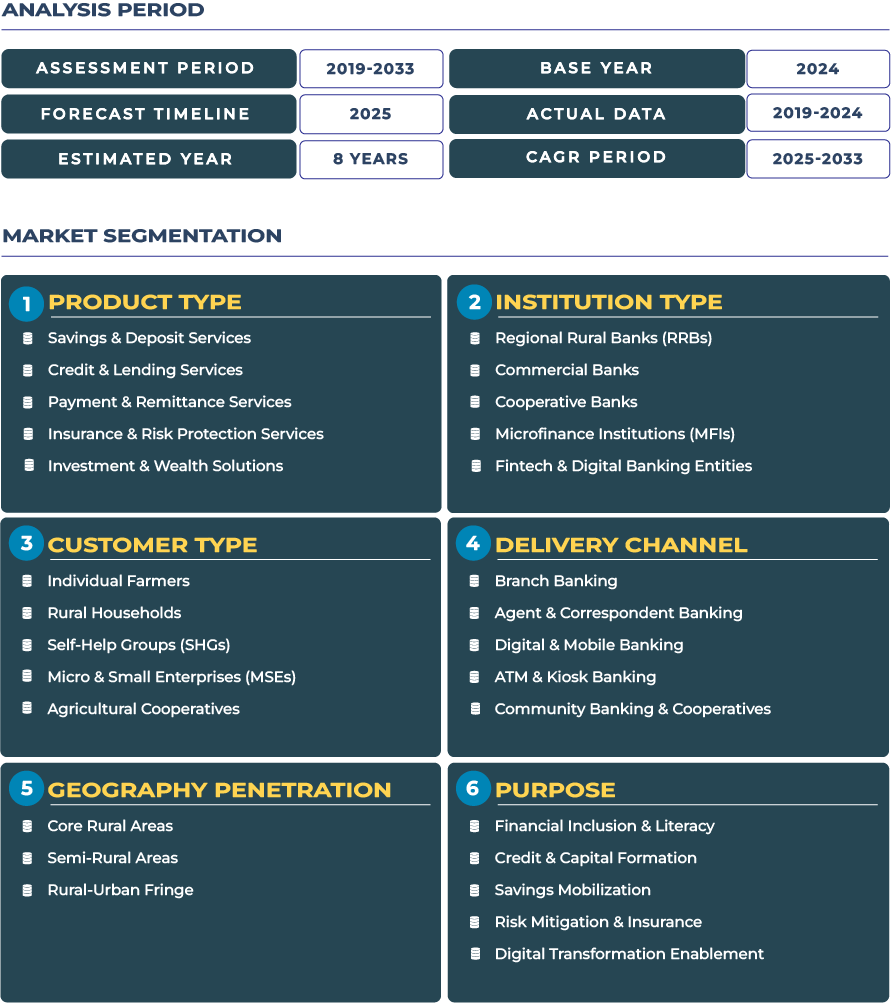Italy Rural Banking Market Outlook: Preserving Heritage through Financial Continuity and Agri-Tourism Growth
Italy rural banking market stands at a pivotal juncture where heritage, continuity, and innovation intertwine to shape the country’s agri-financial landscape. Rooted deeply in centuries-old farming traditions, Italy’s rural banks play an instrumental role in sustaining family-owned estates and fostering intergenerational wealth transfer. In 2025, the Italy Rural Banking Market is valued at USD 10.0 billion and is projected to reach USD 11.1 billion by 2033, growing at a modest CAGR of 1.3%. This steady trajectory reflects a balance between preservation of rural heritage and modernization of agricultural finance mechanisms.
Note:* The market size refers to the total fees/revenue generated by banks through various services.
Post-pandemic economic recalibration and geopolitical complexities in Europe have influenced investment flows and credit access across Italy’s countryside. However, initiatives supported by the Ministry of Economy and Finance and rural programs driven by ISMEA (Istituto di Servizi per il Mercato Agricolo Alimentare) have reinforced farm succession and agri-enterprise credit lines. The market’s direction is increasingly shaped by the need to protect generational ownership, enabling access to succession finance, heritage-linked lending, and agritourism-oriented credit solutions. These instruments not only preserve Italy’s agricultural legacy but also revitalize local economies through sustainable diversification.
Drivers & Restraints: Balancing Heritage Continuity and Structural Constraints
High Agri-Heritage and EU-Driven Funds Strengthen Rural Credit Ecosystems
The Italian rural banking sector benefits from a unique socio-economic backdrop where agriculture, culture, and community overlap. Family-owned farms, many operational for multiple generations, form the cornerstone of Italy’s agricultural economy. The influx of European Union rural development funds and the Common Agricultural Policy (CAP) subsidies are catalyzing investment in modernization and financial literacy. Rural banks such as Credito Valtellinese and Banca Popolare di Sondrio have introduced credit and lending services tailored to agricultural transitions, equipment modernization, and cooperative farming ventures.
Another crucial driver is Italy’s increasing participation in sustainable and organic agriculture markets. With EU green objectives aligning with Italy’s regional strategies, rural banks have become facilitators of low-carbon financing, particularly in renewable energy installations on farms, organic certifications, and irrigation efficiency loans. The integration of digital financial platforms into remote farming communities also supports inclusive finance and formal credit adoption among smaller estates.
Complex Land Inheritance and Limited Bookkeeping Hinder Growth Momentum
Despite positive developments, Italy rural banking growth is constrained by systemic challenges. Inheritance-driven land fragmentation remains a major obstacle, resulting in smaller and economically inefficient farms. This limits collateral value and complicates traditional loan underwriting processes. Many rural households still rely on informal bookkeeping and cash-based operations, creating gaps in credit assessment and compliance with banking standards.
Additionally, regulatory complexities related to land ownership and property transfer impede generational finance mechanisms. The lack of centralized rural financial data across provinces further affects transparency and rural bank scalability. Inflationary pressures and fluctuating energy costs also strain agricultural profitability, dampening repayment capacities and risk appetites among financial institutions.
Trends & Opportunities: Financing Agri-Tourism, Heritage Assets, and Farm Succession
Agri-Tourism Financing and Heritage Restoration Loans Gain Momentum
Italy’s countryside has become a focal point of agritourism expansion, where heritage and hospitality intersect. Rural banks are increasingly offering restoration and agritourism financing products that enable farmers to convert ancestral properties into revenue-generating guesthouses or eco-farms. These initiatives align with national strategies outlined by the Ministry of Tourism, promoting sustainable rural tourism and local employment.
Regional lenders in Tuscany, Umbria, and Lombardy are leading this transformation by introducing asset restoration loans and micro-investment credit lines for farm-to-table ventures and artisanal agri-businesses. These financial products support rural resilience while strengthening Italy’s international appeal as a cultural-agricultural destination. The trend underlines a broader market shift from traditional farm lending to diversified financial services aimed at both production and experience-based economies.
Succession Mortgages and Intergenerational Financing Create Long-Term Stability
One of the most transformative opportunities in the Italy rural banking landscape is the rise of succession-based mortgage products. These offerings are designed to support family-owned farms in generational transitions without disrupting operational continuity. Rural financial cooperatives and regional mutual banks have begun structuring credit models tied to farm heritage, where repayments are linked to long-term agricultural yield or agri-tourism revenues.
This structural innovation encourages younger generations to sustain family farms while reducing migration from rural areas. Banks are coupling these financial tools with digital advisory services and training programs to enhance succession planning and business continuity. The growing influence of rural fintech collaborations is also streamlining access to documentation, remote loan processing, and credit scoring tailored for the agricultural community.
Competitive Landscape: Strategic Consolidation and Rural-Focused Banking Alliances
The Italian rural banking market is moderately fragmented but undergoing steady consolidation as both domestic and international financial institutions expand their rural portfolios. Cooperative banks like Credito Emiliano (CREDEM) and Banca d’Italia-regulated mutual networks continue to dominate local lending, leveraging community trust and regional familiarity.
Recent industry movements highlight growing international interest in rural financial inclusion. For instance, in March, 2025, ING Groep initiated early-stage discussions with Banca Popolare di Sondrio to strengthen its presence in Italy rural and regional banking sector. Such collaborations emphasize long-term strategic goals, including succession-tailored mortgage products and restoration loans linked to projected tourism revenues. The focus on culturally embedded financial instruments positions rural banking as both an economic and social pillar in Italy’s countryside.
Going forward, banks are expected to enhance insurance and risk protection services for climate-resilient agriculture, expand payment and remittance channels for seasonal workers, and integrate sustainability-linked investment offerings that align with Italy’s green transition roadmap. These collective efforts will further consolidate the rural banking ecosystem into a resilient, heritage-driven, and future-ready sector.







